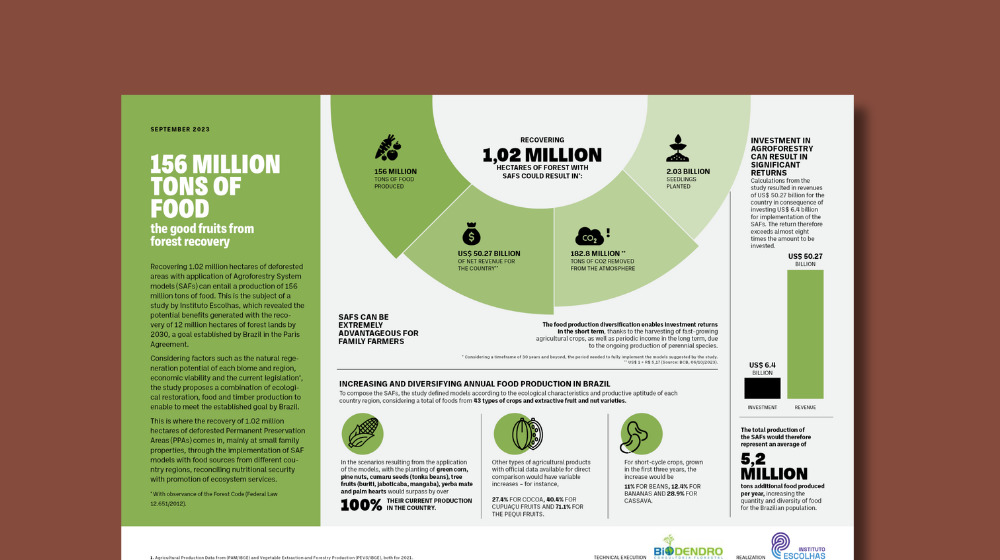Recovering forests on small farms could produce 156 million tons of food

Recovering 1.02 million hectares of deforested areas using Agroforestry Systems (SAFs) models could generate BRL 260 billion (USD 51.3 billion) in net revenue, remove 182.8 million tons of CO2 from the atmosphere and produce 156 million tons of food for the country. The figures are from a new study by Instituto Escolhas, which revealed the benefits that could result from the recovery of 12 million hectares of forestland by 2030, the target set by Brazil in the Paris Agreement. In a new section of the study, the organization shows the potential that lies in recovering deforested Permanent Preservation Areas (PPAs) located on small properties.
“The data reinforces that it is essential to direct resources towards the recovery of forests also on small properties, especially family farms, which have been historically important in the production and diversification of food that reaches the Brazilian table”, states Patricia Pinheiro, project manager at Instituto Escolhas.
According to her, in this case, the choice of SAFs as a forest recovery method was due to the immediate advantages for family farmers. “SAFs allow for a return on investment in the short term, thanks to quick-cycle agricultural crops, and at the same time ensure long-term income, thanks to the cultivation of perennial species”, explains Pinheiro.
Agroforestry systems are characterized by the simultaneous or sequential planting of native trees, fruits and/or timber plants besides agricultural crops. Some SAFs also include animal husbandry.
Increase and diversification of food in Brazil
The SAF models proposed by the study take the ecological characteristics and productive aptitude of the country’s five regions into account. In all, 43 varieties of planted food crops and extractivism were covered.
In the scenarios generated by application of the models, foods such as green corn, pine nuts, cumaru seeds (tonka beans), tree fruits (buriti, jaboticaba, mangaba), yerba mate and palm hearts that would all exceed their current production in the country by more than 100%. For the other 15 foods for which official data is available enabling direct comparison, increases are variable – for instance, 27.4% for cocoa, 40.4% for the cupuaçu fruit and 71.1% for pequi. For short-cycle crops, grown in the first three years, the increase is 11% for beans, 12.4% for bananas and 28.9% for cassava[1].
The total production of the SAFs would therefore represent a yearly total of 5.2 million tons of additional food, increasing quantity and diversity of the food reaching the tables of the Brazilian population. To achieve this target would require the country to invest BRL33.1 billion (USD 6.5 billion) for implementation of the models. “However, the return would reach BRL260 billion (USD 51.3 billion), almost eight times the amount invested”, highlights Pinheiro.
The study is being carried out in partnership with Biodendro Consultoria Florestal. At the beginning of August, on this onepage, Instituto Escolhas published the total amount to be invested by the country to recover the 12 million hectares and their potential benefits. The full study is available here, only in Portuguese.
[1] Data from Agricultural Production (PAM/IBGE) and Vegetable Extraction and Forestry Production (PEVS/IBGE), both for 2021.
Related
Study shows 2,274% increase in herbicide use for soybean production
Brazil attended COP-6 in Minamata without presenting an action plan to address mercury usage in mining
Technical assistance is prevalent in legal regulations and public policies; however, a study indicates that it does not adequately reach rural producers
Study indicate Brazil applies pesticides and fertilizers inefficiently and unsustainably in soybean farming

 Texto
Texto